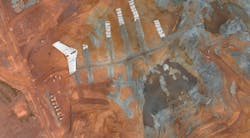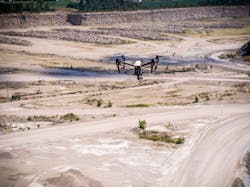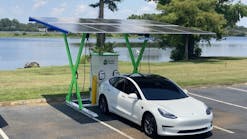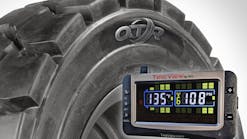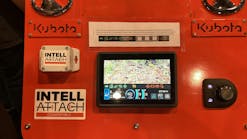Drones, also known as unmanned aerial systems (UAS) or unmanned aerial vehicles (UAV), have improved by leaps and bounds over the last few years, with higher payloads, better cameras, better maneuverability and controllability (including sensors for object detection/collision avoidance), and improved software and systems on the back end for gathering, disseminating, and analyzing data.
Drones are key technology in construction, and the growth will continue. The FAA’s latest five-year Unmanned Aircraft Systems report says that the U.S. commercial drone fleet (small non-model UAS) will nearly triple from 277,386 in 2018 to 835,211 in 2023, an average annual growth rate of almost 25 percent.
As for usage in the construction industry itself, according to a report from Goldman Sachs, construction will one day become the largest user of drones in the United States.
Steps to take with drones
1) Decide what data you want to capture
2) Decide who will run the program
3) Decide who will fly the drone
4) Know when to use a drone
5) Consider partnering with an equipment dealer
Already, the industry is flying more than 10,000, and perhaps even up to 50,000, commercial drones. Whatever the number, it is higher than the drone population of FAA-approved UAVs from only a few years ago. Some construction companies with fleets that include drones say they are experiencing a time savings factor of about 75 percent.
Drones’ role in construction has also evolved. What started as documenting before/after views of projects or gathering video for marketing purposes has added pre-construction surveying, volume/stockpile analysis, project progress, and even site safety, to the growing list of capabilities.
Although there is little doubt a drone program can save time and money by reducing manhours (with site surveying, for example), increasing accuracy (measuring work completed and stockpiles), and fostering decision-making (with the use of data and real-time information), managers still face two major choices in starting a program.
First, like telematics, they have to decide what on the above lists they want to capture and use within a drone program; second, they must make the call on who should run the program and do the flying—whether it is in-house management and piloting, or outsourcing to a turnkey drone solutions provider.
Construction giant and 2013 Construction Equipment and AEMP Fleet Master award winner Bechtel decided to go in-house with its drone program, in part because one of its key employees already had a pilot’s license and was familiar with flying and FAA rules.
“Equipment managers need to learn how these new vehicles can benefit their individual companies, how to specify which drone model is appropriate for their fleet, and how to ensure their drones are inspected, maintained, and operated,” says Joshua Cotton, CEM, Bechtel’s director of flight operations.
Bechtel’s drone fleet allows the company to have complete control over the operation, quality, scheduling, risk management, and safety, according to Wyatt Ferguson, the company’s chief pilot and equipment specialist. “When we do have a situation where we outsource drones to back up our own fleet, we make sure the provider has the capacity, number of drones, pilots, and current staff to commit to the projects that we want to support,” Ferguson says.
Click here to see how Bechtel uses drones for mapping.
Knowing when to use drones is also important, Ferguson said. “They should be deployed during the very first phase of a job, before you have anything built. You want to fly over the site while it is still a grade fill. You can do a survey over the site without having surveyors walk all over the place to get contour and elevation. Then you can design off that information.”
Lyle Ballou, GPS manager for DXI Construction, Churchville, Maryland, decided to use elements of both worlds—in-house piloting and outsourced drone ownership and maintenance—for his company’s program. DXI is a site preparation and utility contractor that was an early adopter of GPS technology.
“I fly topos now with a drone,” Ballou says. “I have my [FAA Part 107] UAV license and I partner with Identified Technologies. I’ve probably got 130 to 140 flights in over the last year.” Identified Technologies is a commercial drone solutions provider; Ballou uses a Topcon system with the drone. DXI does not own the drone but pays a subscription to Identified.
“In my research, it didn’t seem to be value-added to own the drone,” Ballou says. “You would have to maintain it and handle all the updates. And with a monthly subscription, they clean all my data and post it to their websites. I get an email telling me it’s ready. Every flight after the first one is in there, and production can go in with a password; anyone here can have access to that.”
There are also a number of smartphone apps that can help company drone pilots like Ballou. AirMap has features that include drone mapping, geofencing, and flight-logging, as well as information about drone laws in 20 countries.
Another app is UAV Forecast, which focuses on weather. Inputting information about a drone flight into the app will result in basic advice on whether it’s safe to fly or not, as well as detail on wind speed, direction, temperature, windchill, cloud cover, visibility, and possible precipitation.
B4UFly is an app the FAA itself has produced to help pilots know where they can and cannot fly a drone in the U.S. Included is a listing of every airport in the country, with a map of the 5-mile no-fly zone around each.
For an outsourcing approach, companies like DroneDeploy and Delair are among the more turnkey commercial drone suppliers that offer solutions for all aspects of drone operations.
Advantages include the fact that no one at an organization is required to be a trained pilot, and technicians are not required to maintain or fix drones.
Drone Deploy recently expanded all of its products, making a single platform for all drone operations. The expansion includes automated drone fleet management, enhanced workflow integrations, a low-altitude inspection mode, and advanced analytic capabilities.
One product improvement is Earthworks, which has advanced cut and fill capabilities, and new 3D analytics. It allows customers to quantify the amount of earth moved in hours rather than days.
“With Earthworks capabilities, I have the confidence I’m providing my engineers with accurate information in surveying, tracking progress, and verifying contractor work,” says Greg Oetker, an inspector at the Texas engineering firm Jones Carter.
“I’m able to use a map and model to help visualize the site, which makes planning more efficient and accurate,” Oetker says. “This new way of surveying has saved us hours of time each time we go out and capture data.”
Delair recently signed an agreement with Eramet, a global mining firm, in which Delair’s drones and data analytics platform will allow Eramet to develop digital twins of its mining sites and accelerate the digitization of its operational centers to provide Cloud and artificial intelligence services.
Since January, the “Delair.ai” solution has been up and running at the Tiébaghi mine in New Caledonia, an island in the South Pacific, and by the end of the year, it will be used by all of the group’s mines.
Nine drones are currently in operation at Eramet, with an additional nine planned for deployment by the end of this year, including Delair’s fixed-wing UX11 drone. With the Delair end-to-end solution, Eramet will be able to map and analyze around 741,000 acres a year across all of its sites, the company says.
Eramet’s mining sites across New Caledonia, Gabon, Senegal, and Indonesia feature a considerable amount of topographical and geological data. Eramet is planning to build digital twins of its mines in order to control operations in real time, quickly schedule extraction projects, track ore inventories, ensure personnel safety, and manage the environmental impact of its sites.
Combining methods which are five times faster than traditional ways of working with centimeter-level accuracy in drone data collection, Eramet is able to optimize its mining operations, reduce costs, and improve the safety of topographers, Delair says.
Using artificial intelligence-based analytics allows the group to continually measure and update distances, surface areas, volumes, and slopes.
Skyward, a Verizon company, is another provider of drone services. It offers a downloadable e-book, “Drones in Construction: A Guide to Launching Your Program.”
Finally, don’t overlook equipment dealers as sources to help start a program.
Several drone companies have partnered with OEMs, including Kespry (John Deere), and Propeller (Komatsu). Also, familiar technology companies like Topcon and Trimble provide drones and software to gather, analyze, and manage images and data.
